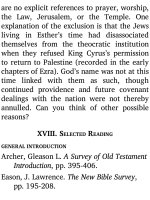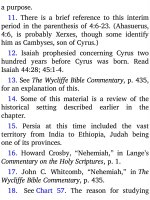Jensens survey of the old testament adam 406
Bạn đang xem bản rút gọn của tài liệu. Xem và tải ngay bản đầy đủ của tài liệu tại đây (150.89 KB, 4 trang )
c. The second period (from Jesus’ ascension
to the destruction of Jerusalem, in A.D. 70) is
when the three synoptic gospels were
written. They mainly report the facts of
Christ’s life. They also include Jesus’
teaching and as much of the writer’s
interpretation as God deemed necessary for
that time.
CHART 40: PLACE OF JOHN’S GOSPEL IN FIRSTCENTURY HISTORY
d. The third period begins after the fall of
Jerusalem and reaches to the end of the
century. It was a time of consolidation,
organization, and re ection in the Christian
communities of the Mediterranean world. In
A.D. 85 God inspired John to write the fourth
gospel, to include key facts of the gospel but
extensively to interpret those facts for the
reader. John writes as the re ective
theologian, with a main purpose of
establishing the foundational truth of the
deity of Christ. Do you see the logical order
of:
HISTORICAL FACTS → REPORTED FACTS
→ INTERPRETATIONS
e. John’s gospel also
ts into the
transitional scheme of God’s revelatory
program:
(1) The Old Testament prophets, Jesus,
and the early disciples preached rst to
Israel.
(2) Matthew’s gospel was directed
primarily to Jews; Mark’s to Romans; and
Luke’s to Gentiles.
(3) John’s perspective was particularly
worldwide, with references to Jew, Roman,
and Greek kept more in the background.
2. Now consider other aspects before
beginning your survey studies. For example,
what is perhaps the most-quoted verse in the
New Testament? Do you see any signi cance
that it is in this fourth gospel by John?
3. Review Chart 18, page 108, and think
especially of John’s gospel as you observe
the comparisons of the four gospels.
4. Read the opening verse of each of the
synoptic gospels. (Read Luke 1:5 in place of
Luke 1:1.) Then read the rst verse of John.
What are your reflections?
5. Prepare your heart and mind to have
open eyes and a receptive spirit as you
survey this precious book of God.
II. BACKGROUND
A. AUTHOR









